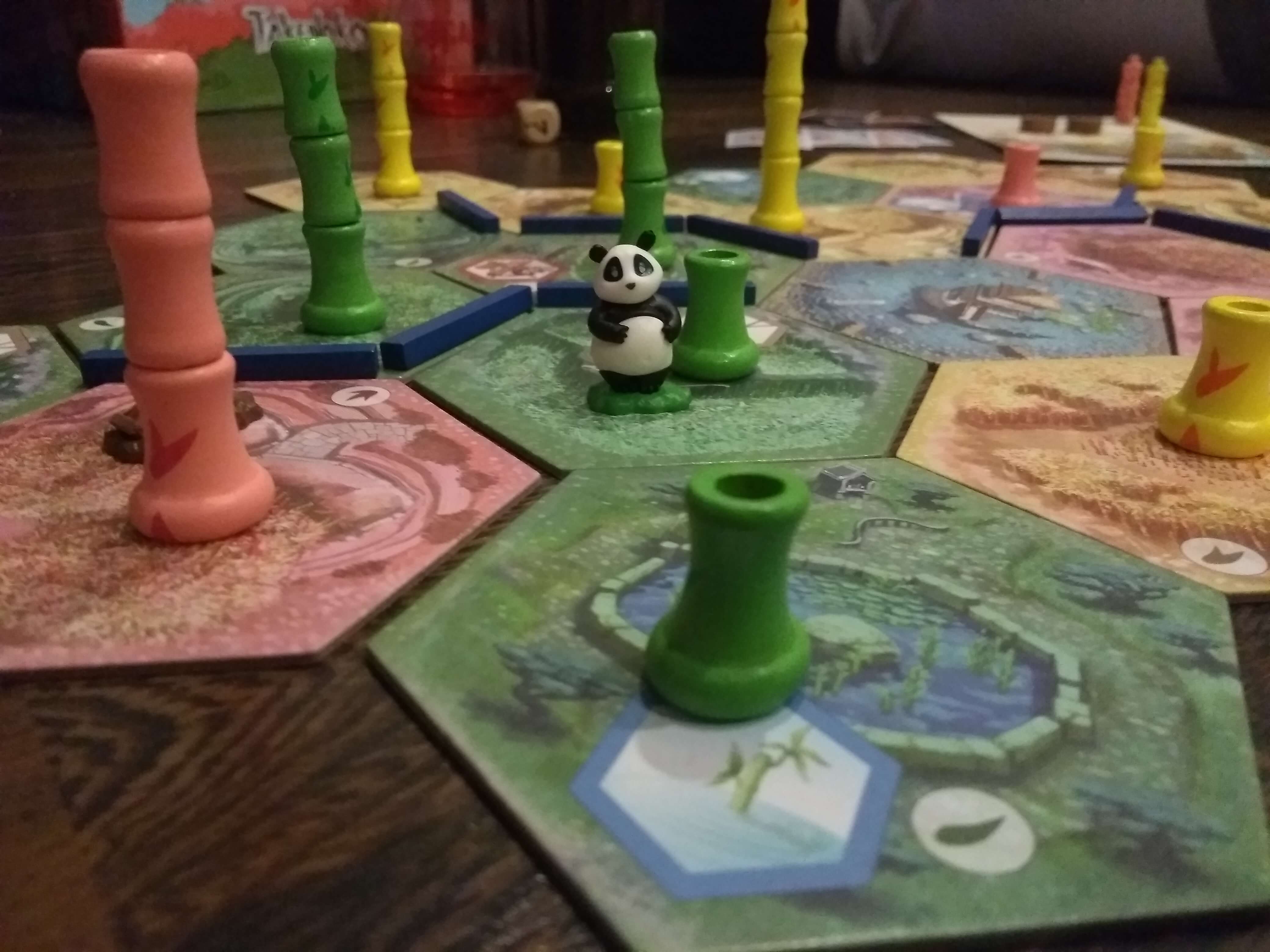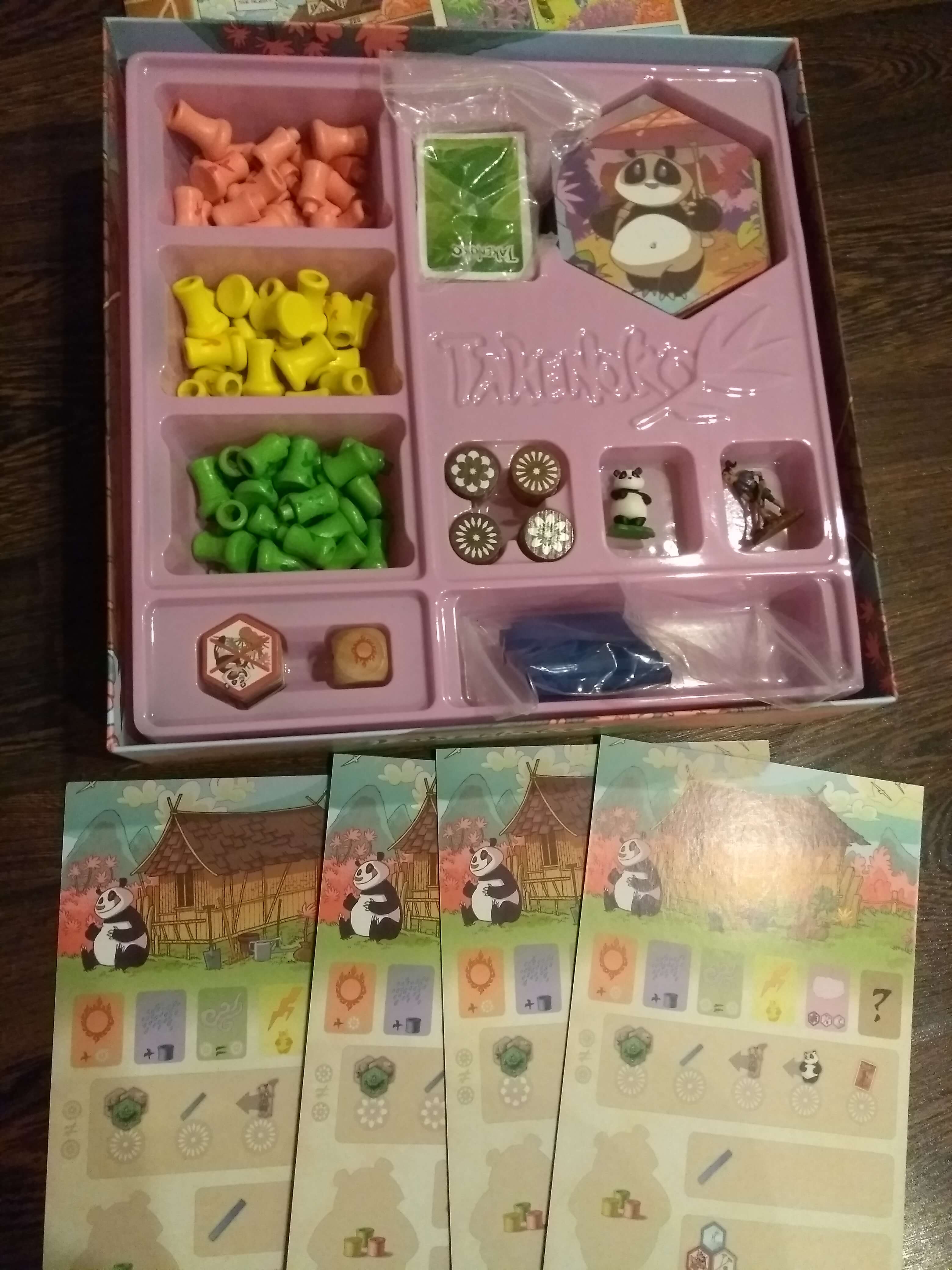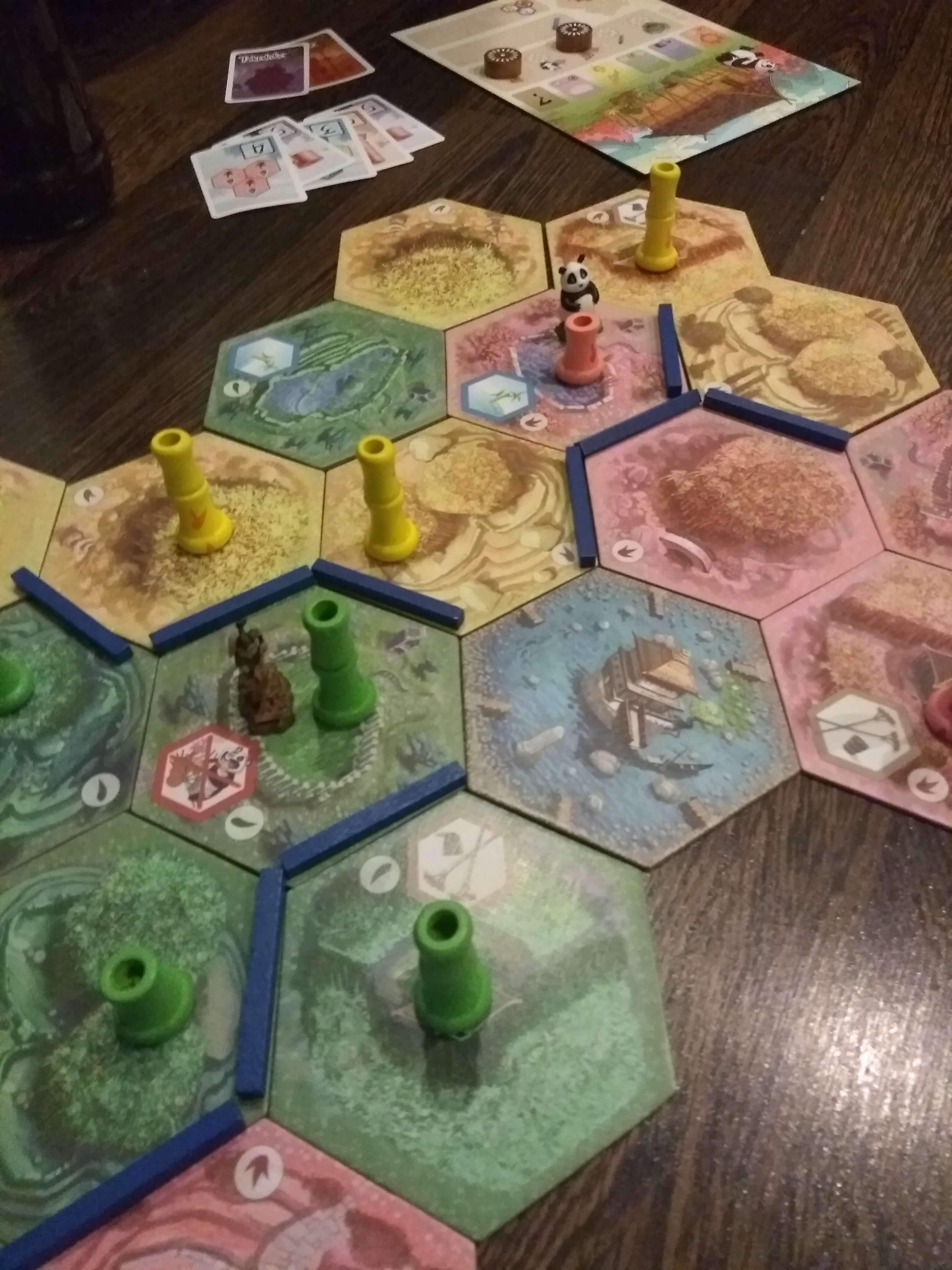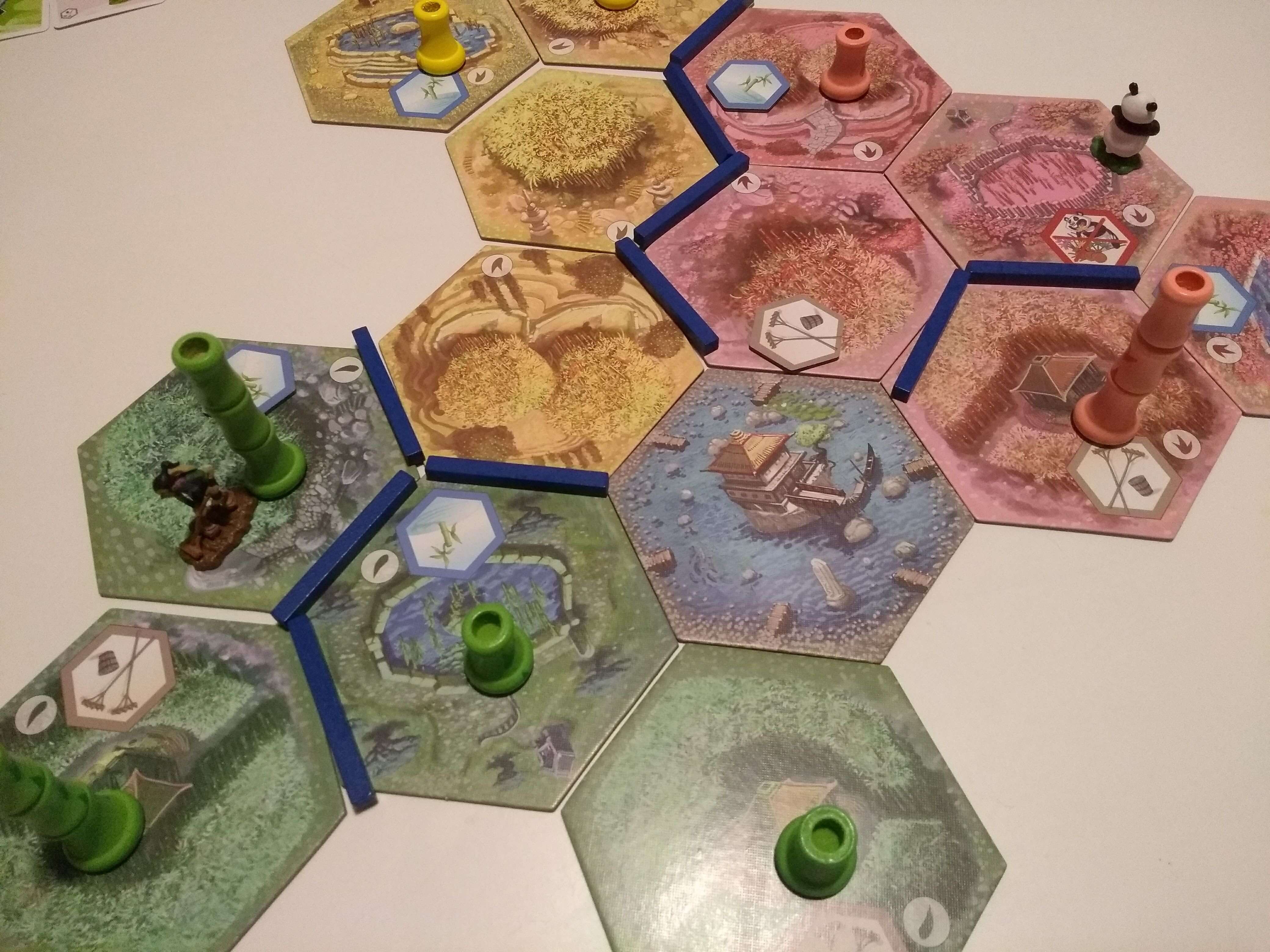Takenoko — Build bamboo and eat it up
Takenoko is a surefire family favorite, a game that many, many people have heard of and played previously. As someone who has recently gotten into board games, I couldn’t pass up on the adorable box, big panda, and interesting looking tiles. This game even comes with a little comic on the instructions!
Takenoko is about a panda being gifted to a nation after a huge war. This panda is a cute creature — one that moves around a giant bamboo garden. There is also a gardener of course, who is tending to the bamboo garden areas, and looking after the panda. These are represented by cute plastic characters that you can move around!
Overview
In Takenoko, you need to complete various mission cards in order to gain the most points possible. There are three main types of missions; panda missions that require eating bamboo, gardener missions that require set colors and amounts of bamboo to be grown, and land missions that require specific patterns of land to be grown. These cards also have a number in the bottom left hand corner which show how many points you’ll get for completing the action.
Each player also gets a large card that shows various actions and hints, as well as two circular coins that represent the two actions they can do on their turn. These can be placed on the large player card, showing what actions were used. This card also acts as an inventory for waterways and eaten bamboo.
The entire game starts around the center of the garden; a fountain. When you start playing, this is the only tile that is placed out. Your panda and gardener are placed on this tile. When it is your turn, you are able to do two of the following actions; picking up three tiles and placing one onto the board, gaining a water stream, which can be placed either now or later (if placed later doesn’t cost an action token), pick up a new mission card, move the gardener, or move the panda.
When it comes to placing tiles, which will be the majority of the beginning of the game, you will need to place a tile either connected to the center fountain, or touching other tiles on two sides. Tiles attached to the middle fountain will be instantly irrigated. This means that the matching colored bamboo (either yellow, pink, or green) will be grown instantly on the tile — this is also true if the tile has an irrigation icon printed on it, regardless of where it is placed. If the tile doesn’t have that icon and isn’t attached to the fountain, water streams need to be placed to it, in order to grow bamboo.
Bamboo will grow the first time a tile is irrigated, and whenever the gardener moves towards it. The gardener and panda can move in any direction, in a straight line, from the tile they are currently on. The last tile they land on is the one affected. When it comes to the gardener, this means adding a bamboo piece, up to four high, to the tile. When it comes to the panda, this means eating the bamboo and adding it to your inventory.
You will need to solve your mission cards, placing them down on your turn when you have completed them. Eventually, one of the players will have played enough of these, which will end the game. The number changes depending on the number of players you have in the specific game.
Components
This game does have a lot of pieces, which fit well into the box. There are a bunch of tiles, divided into three colors to represent the various colors of bamboo. These end up building out your board. A smaller set of tiles also can add various abilities to the larger board tiles; fertilizer to make two bamboo grow at the same time, irrigation tiles to make a tile automatically irrigated, and a no eat tile that can make it so that pandas are unable to nom on the tasty bamboo growing there.
There are also little cards that showcase missions, also coming in three colors, and a bonus emperor mission card that is used towards the end of the game. Each player also gets a player card, which is quite large and stays by them. There are wooden circle tokens, two per player, for a total eight tokens. As for wooden pieces, the water streams are also wooden rectangles, and there are three different colors of bamboo pieces — these pieces come in two types, a base that can sit on the board, and then connection pieces that can stack on top of it.
Takenoko also comes with a weather dice, which you can use optionally to add various bonus moves that can happen at the start of the game. There are two little characters; the gardener and the panda.
That’s basically it!
Turn structure
At the start of a round, if you are playing with the weather dice, that will be rolled. From there, when it’s your go, you get to pick two actions to play. Most of the time, for me, this was grabbing three tiles that can be placed on the board, then picking the one I wanted to place and putting the other two back on the bottom. That costs one move. The other move I tend to go for is moving the gardener to grow bamboo or moving the panda to eat bamboo. A lot of your moves will depend on your mission, as you will be chasing these missions to gain points.
You can grab water streams for your inventory or draw a new mission card as well, just each action takes a single action coin. Once you are done with your two actions and have placed, face up, any mission cards you have finished, it will move on to the next player. You will need to think strategically and watch other player’s moves if you want to stop them from completing whatever mission you think they are going after. This then continues until someone has completed a specified number of mission cards, depending on how many players you have. After that, there is one last turn, and then the game ends. The player with the most points wins.
Game experience
I’ve now played Takenoko with a few different board game groups as whenever I bring it around places, people select it out of the options either claiming it’s a favorite of theirs or loving the box artwork. Each time, I have found the game to be adorable and fun. The missions are challenging, the tiles look great, the entire game is super colorblind friendly — it’s a favorite to most for a reason!
On a personal note, I also really enjoy stacking up the various bits of bamboo, seeing them grow on the tiles as the game continues on. Your garden, between the streams of water and various bits of colored bamboo, can end up looking very lovely.
This game is more than a cute package, it’s fun to try and figure out the best way to complete your missions, see how you can move more efficiently than your competitors, and place tiles in the best way to gain water and irrigation. With the limited number of water streams, you have to think in creative ways if you don’t end up with a few of these left in your inventory.
Conclusion
As I said above, Takenoko is simply a well made, fun game. It’s still one you can find at shops and in board game cafes because of how popular and fun to play it is. The game does take a bit of setting up and the instructions are a bit long, but once you get into the game and have played it a few times, you do get the hang of it and can really enjoy all of the features like the weather dice. It’s a great game to play with your family, with your friends, or with strangers who are just into a panda and colorful bamboo.
A copy of Takenoko was provided for review purposes. You can pick up your own copy on Amazon.





Sorry, this is not colorblind friendly. Speaking from experience as a colorblind person.